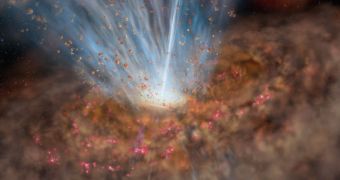A team of astronomers has determined that even the Universe's largest black holes are capable of limiting their own growth, through a very simple mechanism. They engulf surrounding matter with such speed and greed, that they cast away large amounts of material in the process.
This is the discovery the group made while analyzing a supermassive black hole located at the core of a galaxy very far away from Earth. Due to the intensity of the accretion process, a huge plume of matter was found to be expelled from the structure into its surroundings.
What the black hole is doing now is literally signing its own death certificate. It is throwing away its next meals, essentially setting the stage for its own starvation. But the structure will not go down alone, as it will take its host galaxy with it.
Without the activity of the black hole at its core, the host galaxy will stop producing new stars in large quantities. This will in turn mark the beginning of its decline and aging, experts say.
In the new investigation, scientists discovered a huge amount of gas and dust emanating from the dark behemoth at the core of Markarian 231 (Mrk 231), a galaxy located some 600 million light-years away.
“This is really a last gasp of this galaxy. The black hole is belching its next meals into oblivion,” says University of Maryland expert Sylvain Veilleux, also the author of the new study.
In order to observe the distant Mrk 231, the investigators used the Hawaii-based Gemini Observatory to look in the direction of Ursa Major, Space reports. This observatory is tremendously powerful, and also suitable for conducting such research.
Analyses demonstrated that the supermassive black hole in Mrk 231 has the weight equivalent of ten million solar masses. Its host galaxy is now in the final stages of merging with another galaxy.
This process stirs up cosmic dust and hydrogen gas reserves, and feeds the black holes in the two galaxies. But the availability of “food” is apparently too much for the one the experts studied.
It is spewing out material at a speed of about 2.2 million miles per hour (3.5 million kph), experts say in a paper that will appear in the March 10 issue of the esteemed Astrophysical Journal Letters.
“The crucial thing is that the fireworks of new star formation and black hole feeding are coming to an end, most likely as a result of this outflow,” explains Rhodes College scientist and study coauthor David Rupke.
The reason why stellar formation will stop at the core of Mrk 231 is that the black hole is removing vast amounts of gas from the galactic core that would have otherwise been used to form new stars.

 14 DAY TRIAL //
14 DAY TRIAL //